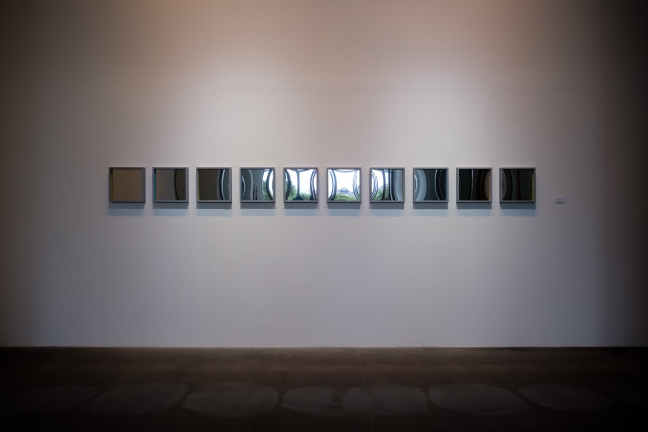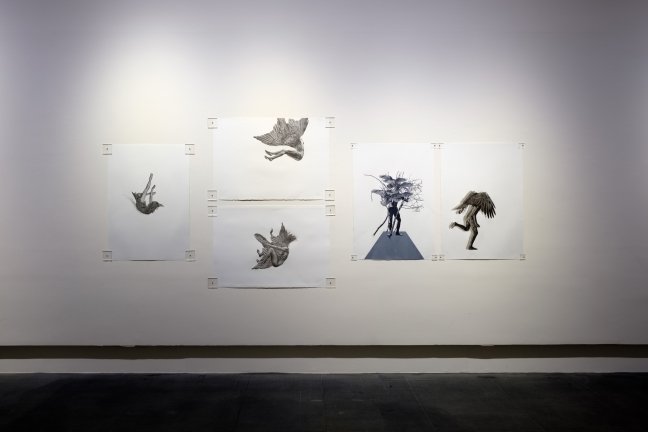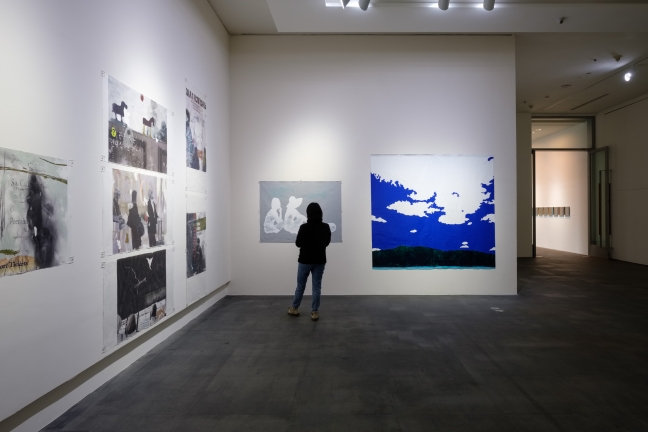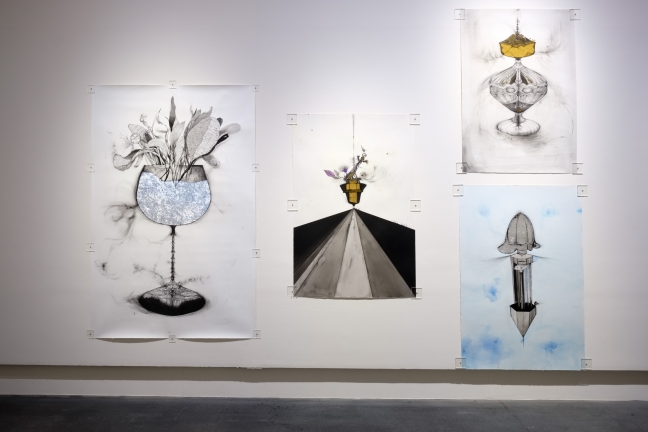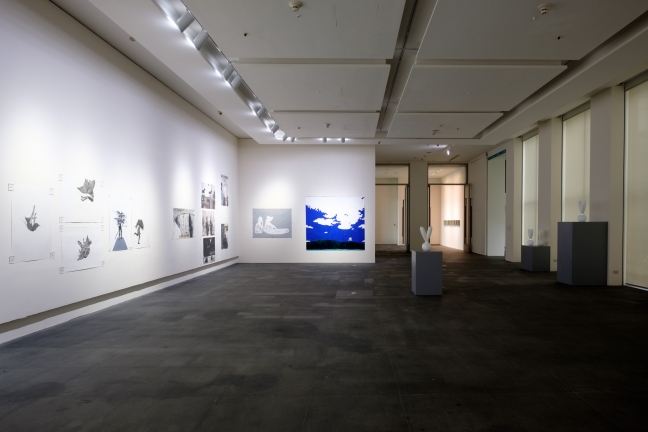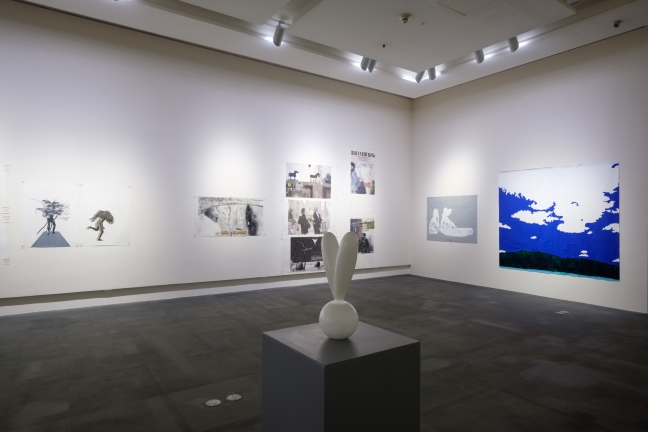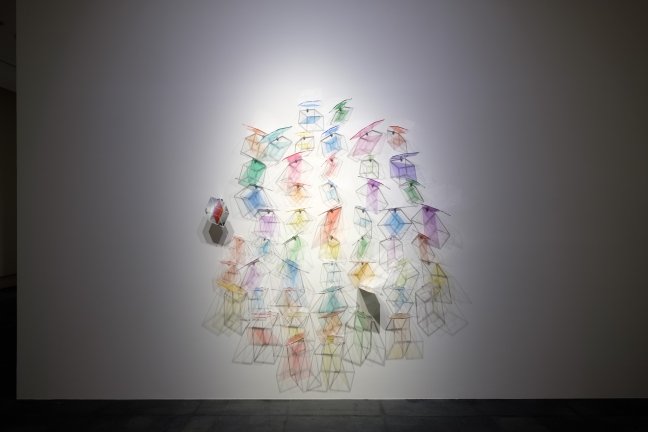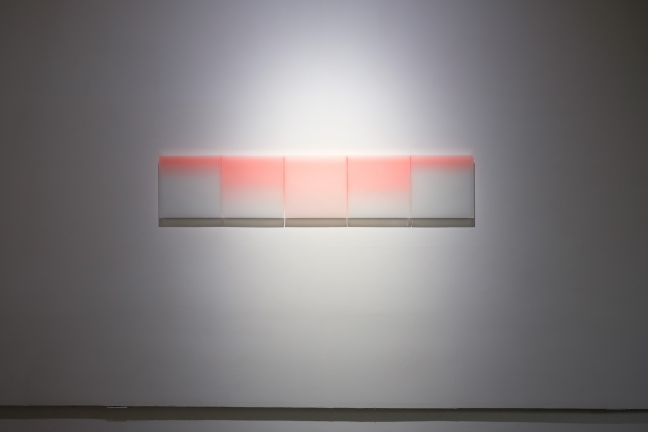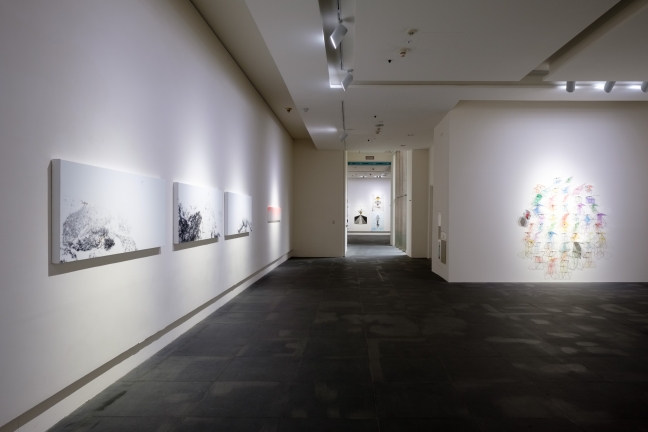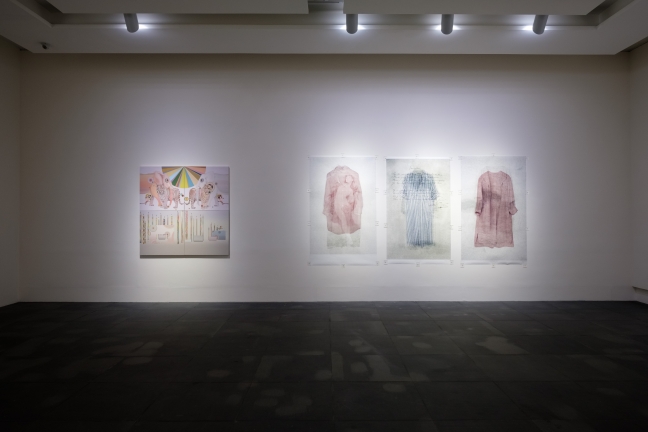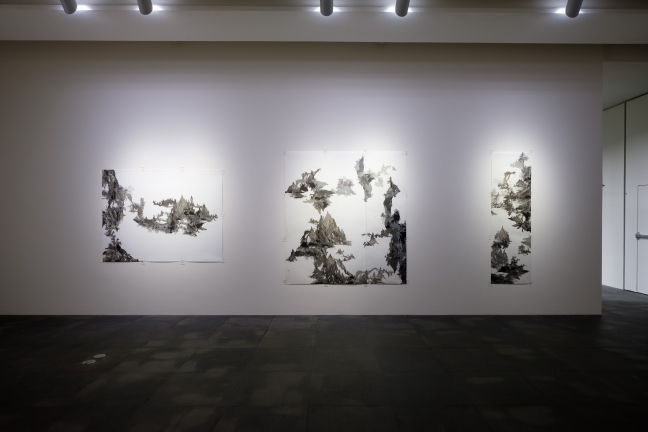Sense and Sensibility – Works by Korean Women Artists
2017.02.24~2017.04.16
09:00 - 17:00
Curators|Kim Yong-Sik, Wang Li-Ya Artists|Bang In-Hee, Choi Na-Ri, Choi Youn-Joung, Han Ji-Min, Jang Su-Im, Jung Eun-A, Jung Woo-Ri, Kim Hyo, Kim Yi-Su, Ko Eun-Gyeong, Lee Choon-Ok, Lee Gang-Yoo, Lim Hyun-Jin, Lim Jeoung-Eun, Yi Hyun-Joo 【INTRODUCTION】 Sense and Sensibility is an exhibition that features 15 Korean women artists of different generations. This exhibition presents to the viewer an insight into the art scene of Korean contemporary women artists and their artistic expressions. It shows both the logical and emotional sides of the artist when they interpret the era of which each artist belongs to. After Korea liberated itself from Japan, the Korean War followed, which divided the country into two nations. Due to such a painful history, Korea went through a rapid and chaotic development from mid 1950s to the 1990s. Korean art consequently developed in a short period of time. By viewing the works of these 15 artists, one can understand the changes and the development of Korean art throughout the transitional years. In presenting their artworks, this exhibition is endeavoring to present insights into Korean contemporary women artists and their artistic expressions through different generations. The participating artists are born in the years between the 1950s and the 1980s. Although they do not share the same artistic backgrounds and major, they are all elites who studied their master or doctoral degree in painting or printmaking at Sung Shin Women’s University. They are also artists who are actively participating in local and international contemporary art scene, pushing through boundaries and going back and forth different genres in order to seek for new expression and ideas in art. In the works of all artists lies a sense of contemplation in which restrained beauty of well-balanced reason and emotion is shown. Some may think that emotion takes priority over logic in artistic expression. However, emotion is shown in relation with logic. In an artwork, the psychological world of an artist is presented, which reflects both logic and emotion about the artist’s situation he or she belongs to. Therefore, this exhibition tries to show the viewers observe the
logic and emotion” of the artists in the time of Korea’s compressed modernization process. It is also aims to present to the viewers an understanding of Korean contemporary art scene and how women artists lead their roles in the time where women power is highly appreciated.
logic and emotion” of the artists in the time of Korea’s compressed modernization process. It is also aims to present to the viewers an understanding of Korean contemporary art scene and how women artists lead their roles in the time where women power is highly appreciated.
Curators|Kim Yong-Sik, Wang Li-Ya Artists|Bang In-Hee, Choi Na-Ri, Choi Youn-Joung, Han Ji-Min, Jang Su-Im, Jung Eun-A, Jung Woo-Ri, Kim Hyo, Kim Yi-Su, Ko Eun-Gyeong, Lee Choon-Ok, Lee Gang-Yoo, Lim Hyun-Jin, Lim Jeoung-Eun, Yi Hyun-Joo 【INTRODUCTION】 Sense and Sensibility is an exhibition that features 15 Korean women artists of different generations. This exhibition presents to the viewer an insight into the art scene of Korean contemporary women artists and their artistic expressions. It shows both the logical and emotional sides of the artist when they interpret the era of which each artist belongs to. After Korea liberated itself from Japan, the Korean War followed, which divided the country into two nations. Due to such a painful history, Korea went through a rapid and chaotic development from mid 1950s to the 1990s. Korean art consequently developed in a short period of time. By viewing the works of these 15 artists, one can understand the changes and the development of Korean art throughout the transitional years. In presenting their artworks, this exhibition is endeavoring to present insights into Korean contemporary women artists and their artistic expressions through different generations. The participating artists are born in the years between the 1950s and the 1980s. Although they do not share the same artistic backgrounds and major, they are all elites who studied their master or doctoral degree in painting or printmaking at Sung Shin Women’s University. They are also artists who are actively participating in local and international contemporary art scene, pushing through boundaries and going back and forth different genres in order to seek for new expression and ideas in art. In the works of all artists lies a sense of contemplation in which restrained beauty of well-balanced reason and emotion is shown. Some may think that emotion takes priority over logic in artistic expression. However, emotion is shown in relation with logic. In an artwork, the psychological world of an artist is presented, which reflects both logic and emotion about the artist’s situation he or she belongs to. Therefore, this exhibition tries to show the viewers observe the
logic and emotion” of the artists in the time of Korea’s compressed modernization process. It is also aims to present to the viewers an understanding of Korean contemporary art scene and how women artists lead their roles in the time where women power is highly appreciated.
logic and emotion” of the artists in the time of Korea’s compressed modernization process. It is also aims to present to the viewers an understanding of Korean contemporary art scene and how women artists lead their roles in the time where women power is highly appreciated.
Food, clothing, and shelter are the three necessities of life. They are indispensable. In the modern society, clothing has multiple meanings. In case of uniforms, they represent ranks or specific social groups. Clothing reveals a social class status of a person depending on country of time period. It is also a means of expression showing one’s characteristics and wealth. However, they are not the meanings that I pay attention to. There is something special about distorted shabby old clothes, which cannot be found in brand new and unworn clothes. I assume that worn clothes contain the whole history of a person and thus, they can be an object representing that person. Then, what are the meanings of clothes to me? I want to define clothes as “special object” that have obtained an identity while one’s distinctive body smell and the elements of time art accumulated in them. They become an instrument that generates a new story each time when a memory is added to them. In other words, the combination of “substance (clothes) and memories” together, becomes an instrument that can ignite itself incessantly.
Food, clothing, and shelter are the three necessities of life. They are indispensable. In the modern society, clothing has multiple meanings. In case of uniforms, they represent ranks or specific social groups. Clothing reveals a social class status of a person depending on country of time period. It is also a means of expression showing one’s characteristics and wealth. However, they are not the meanings that I pay attention to. There is something special about distorted shabby old clothes, which cannot be found in brand new and unworn clothes. I assume that worn clothes contain the whole history of a person and thus, they can be an object representing that person. Then, what are the meanings of clothes to me? I want to define clothes as “special object” that have obtained an identity while one’s distinctive body smell and the elements of time art accumulated in them. They become an instrument that generates a new story each time when a memory is added to them. In other words, the combination of “substance (clothes) and memories” together, becomes an instrument that can ignite itself incessantly.
Choi Na-Ri’s works allow the content to be symbolic, and colors play an important role in her works. By starting visualizations of gender antagonism and human relationships, she has been showing human's diverse desires, including not only appetite and sexual desire but also social desire and desires of making relationships and realizing one's ideal. In her work, colors take a role of dividing two contrast beings of male and female when containing possibilities of harmonizing. In the beginning, colors were followed by a common concept; bluish colors for men and pinkish colors for women in order to deliver messages about matters in the social fixed idea. Then, her focus moved to the arrangement of colors which makes colors stand out and hide depending on the density. She has been solving her idea of the relationship about people through the harmonizing and contrast aspects of colors. Her work aims to reveal reality cheerfully and sometimes critically from her experiences of human's diverse desires.
Choi Na-Ri’s works allow the content to be symbolic, and colors play an important role in her works. By starting visualizations of gender antagonism and human relationships, she has been showing human's diverse desires, including not only appetite and sexual desire but also social desire and desires of making relationships and realizing one's ideal. In her work, colors take a role of dividing two contrast beings of male and female when containing possibilities of harmonizing. In the beginning, colors were followed by a common concept; bluish colors for men and pinkish colors for women in order to deliver messages about matters in the social fixed idea. Then, her focus moved to the arrangement of colors which makes colors stand out and hide depending on the density. She has been solving her idea of the relationship about people through the harmonizing and contrast aspects of colors. Her work aims to reveal reality cheerfully and sometimes critically from her experiences of human's diverse desires.
I seek to create an ideal space and to present a space of contemplation through the media of painting. This ideal space is a place where binary concept does not exist. It is also a place where my concept of “ideal reasoning” exists creating a world of inner purification. Through my work, I try to present to the people that are isolated in our contemporary society an ideal place where there is no conflict, competition, and/or physical inequality. In that space exist no social rules or regulations based on binary concept such as good or evil, truth or deception. Finally, one is free from the physical time and given pure time of natural light so that one can return back to the natural world that God has created. In reality, it is impossible to live in such space. The space presented in my work is a space where one can experience fundamental contemplation and revive their body and the mind rather than a place of escape from the reality. It is a place where no particular thinking consumes our mind, like a space of purity where no mind-state exists. Thus, it is an expression of my ideal reality. Through this ideal reality, I seek for the eternal structure of the nature rather than the ever-changing outer-form of reality, and this is shown through the invisible world rather than the visible world, and also through the spatial expression of the inner mind that can be felt from the rhythm of nature.
I seek to create an ideal space and to present a space of contemplation through the media of painting. This ideal space is a place where binary concept does not exist. It is also a place where my concept of “ideal reasoning” exists creating a world of inner purification. Through my work, I try to present to the people that are isolated in our contemporary society an ideal place where there is no conflict, competition, and/or physical inequality. In that space exist no social rules or regulations based on binary concept such as good or evil, truth or deception. Finally, one is free from the physical time and given pure time of natural light so that one can return back to the natural world that God has created. In reality, it is impossible to live in such space. The space presented in my work is a space where one can experience fundamental contemplation and revive their body and the mind rather than a place of escape from the reality. It is a place where no particular thinking consumes our mind, like a space of purity where no mind-state exists. Thus, it is an expression of my ideal reality. Through this ideal reality, I seek for the eternal structure of the nature rather than the ever-changing outer-form of reality, and this is shown through the invisible world rather than the visible world, and also through the spatial expression of the inner mind that can be felt from the rhythm of nature.
Worshipers convince themselves that they share an extraordinary power with beings that are superior to humans and find psychological comfort by possessing of the subject they worship. Borrowing from the principle of totemism, my work demonstrates my personal totem I have chosen. The sacred subjects of primitive religions usually represent the group symbolically. Nevertheless, the fundamental nature of totemism is more of a solicitude or reliance that is based on the faith. According to this inherent nature, I take the totem as my personal symbol of the network that is related to my memories. My personal totem in my work is a bird. This comes from a childhood memory where I used to adore the freedom and strength reflected in the bird’s wings and beak. The bird’s figure is a symbolic representation of perfection, in contrast to the human body that represents insecure emotions like anxiety and fear. Through these symbols I seek emotional liberation and discussion about our desire to be perfect. The white background and black figures used in the works represent the black silhouette that travels from night till dawn. A night always moves into dawn. Just like such natural principles, I wish this imagery and ritualistic movement in my work to become my own myth, leading us to the transcendental space beyond reality.
Worshipers convince themselves that they share an extraordinary power with beings that are superior to humans and find psychological comfort by possessing of the subject they worship. Borrowing from the principle of totemism, my work demonstrates my personal totem I have chosen. The sacred subjects of primitive religions usually represent the group symbolically. Nevertheless, the fundamental nature of totemism is more of a solicitude or reliance that is based on the faith. According to this inherent nature, I take the totem as my personal symbol of the network that is related to my memories. My personal totem in my work is a bird. This comes from a childhood memory where I used to adore the freedom and strength reflected in the bird’s wings and beak. The bird’s figure is a symbolic representation of perfection, in contrast to the human body that represents insecure emotions like anxiety and fear. Through these symbols I seek emotional liberation and discussion about our desire to be perfect. The white background and black figures used in the works represent the black silhouette that travels from night till dawn. A night always moves into dawn. Just like such natural principles, I wish this imagery and ritualistic movement in my work to become my own myth, leading us to the transcendental space beyond reality.
My works generally focus on people’s everyday life in cities. I observe streets, markets, parking lots, and other public spaces to use for the materials of my art. I look into details such as tape and glue marks left on the wall after a flyer has been removed, the wrinkles and words on advertisements, and stains on roads to express busy lives of those who live in cities through modern images. I capture urban sceneries and gather newspaper, magazine, and poster images. First, I choose words that catch my eyes and collect related images to combine with the letters. Although the images are formed with my personal insights, I believe many people will share the same feelings towards my work.
My works generally focus on people’s everyday life in cities. I observe streets, markets, parking lots, and other public spaces to use for the materials of my art. I look into details such as tape and glue marks left on the wall after a flyer has been removed, the wrinkles and words on advertisements, and stains on roads to express busy lives of those who live in cities through modern images. I capture urban sceneries and gather newspaper, magazine, and poster images. First, I choose words that catch my eyes and collect related images to combine with the letters. Although the images are formed with my personal insights, I believe many people will share the same feelings towards my work.
I draw everyday object around me. I imbue them with curiosity and keep looking at what we have looked differently. Sometimes I transform everyday objects around us. I choose a part of objects, and then I combine and construct the selected parts in a unique way. The newly constructed object takes a form so ambiguous that it can't be named anything. The way I receive the objects thereby shows my own emotion and memory of objects. I want the audience to look at a familiar object that they never appreciated from a different perspective. I want to initiate a new experience deviated from customs by suggesting familiar and unfamiliar way of looking.
I draw everyday object around me. I imbue them with curiosity and keep looking at what we have looked differently. Sometimes I transform everyday objects around us. I choose a part of objects, and then I combine and construct the selected parts in a unique way. The newly constructed object takes a form so ambiguous that it can't be named anything. The way I receive the objects thereby shows my own emotion and memory of objects. I want the audience to look at a familiar object that they never appreciated from a different perspective. I want to initiate a new experience deviated from customs by suggesting familiar and unfamiliar way of looking.
My works is a motion of pallet proliferation by the release of suppression from coagulation condition.
Feature makes to translate it into another feature. Body gets to proliferate and float.
As much as proliferating and floating, contradicted-experience and memory also becomes watered down.
Contradiction can expand its own meaning as the tax rate that women should pay for in this society and even a suppression of body that might happen on the condition of patriarchal environment.
However, it should not be taken as the same astute argument in womanhood in accordance with the thesis, written above.
It should be true that my conversation has been truly interacting with the dimension of body, and this body shall not only be restricted as sexual identification but also as a nature, the World.
……
This world is the world that should be humble in beating and that cannot be known as like landscape in the mist.
Feature makes to translate it into another feature. Body gets to proliferate and float.
As much as proliferating and floating, contradicted-experience and memory also becomes watered down.
Contradiction can expand its own meaning as the tax rate that women should pay for in this society and even a suppression of body that might happen on the condition of patriarchal environment.
However, it should not be taken as the same astute argument in womanhood in accordance with the thesis, written above.
It should be true that my conversation has been truly interacting with the dimension of body, and this body shall not only be restricted as sexual identification but also as a nature, the World.
……
This world is the world that should be humble in beating and that cannot be known as like landscape in the mist.
My works is a motion of pallet proliferation by the release of suppression from coagulation condition.
Feature makes to translate it into another feature. Body gets to proliferate and float.
As much as proliferating and floating, contradicted-experience and memory also becomes watered down.
Contradiction can expand its own meaning as the tax rate that women should pay for in this society and even a suppression of body that might happen on the condition of patriarchal environment.
However, it should not be taken as the same astute argument in womanhood in accordance with the thesis, written above.
It should be true that my conversation has been truly interacting with the dimension of body, and this body shall not only be restricted as sexual identification but also as a nature, the World.
……
This world is the world that should be humble in beating and that cannot be known as like landscape in the mist.
Feature makes to translate it into another feature. Body gets to proliferate and float.
As much as proliferating and floating, contradicted-experience and memory also becomes watered down.
Contradiction can expand its own meaning as the tax rate that women should pay for in this society and even a suppression of body that might happen on the condition of patriarchal environment.
However, it should not be taken as the same astute argument in womanhood in accordance with the thesis, written above.
It should be true that my conversation has been truly interacting with the dimension of body, and this body shall not only be restricted as sexual identification but also as a nature, the World.
……
This world is the world that should be humble in beating and that cannot be known as like landscape in the mist.
The “Everyday Life-Holidays” series was originated from my own experience. The memories include personal trips for treating physical and mental exhaustion caused by overwork and various situations happened at vacation places where I spent delightful time with my family or friends. The etymology of vacation is vacatio, a latin word which means “being free from something”. I work most days of twelve months a year, hard dreaming a vacance to be free from everyday life. It is kind of a reward which is given only when I do my utmost. For me, a vacance is more than something for fun. It is a process in which I direct my energies as much as I can to it and then refill energies for achieving more things. I intend to show my dreamy vacance that I personally experienced.
The “Everyday Life-Holidays” series was originated from my own experience. The memories include personal trips for treating physical and mental exhaustion caused by overwork and various situations happened at vacation places where I spent delightful time with my family or friends. The etymology of vacation is vacatio, a latin word which means “being free from something”. I work most days of twelve months a year, hard dreaming a vacance to be free from everyday life. It is kind of a reward which is given only when I do my utmost. For me, a vacance is more than something for fun. It is a process in which I direct my energies as much as I can to it and then refill energies for achieving more things. I intend to show my dreamy vacance that I personally experienced.
Kim Yi-Su expresses the tiny difference of the boundary with a landscape of the horizon and the sky. Repeatedly attaching translucent tape painted with acrylic on the surface or inserting threads in acrylic box horizontally and vertically, the artist creates a kind of spatial depth. For this work, she employed the concept of “inframince” coined by Marcel Duchamp. This mysterious concept indicates the something in between the two-dimensional and the three-dimensional.
Kim Yi-Su expresses the tiny difference of the boundary with a landscape of the horizon and the sky. Repeatedly attaching translucent tape painted with acrylic on the surface or inserting threads in acrylic box horizontally and vertically, the artist creates a kind of spatial depth. For this work, she employed the concept of “inframince” coined by Marcel Duchamp. This mysterious concept indicates the something in between the two-dimensional and the three-dimensional.
Image of people who try to inject and reflect themselves to an artificial space made by someone else have always fascinated me. I have been using mirror, which is a multidimensional object in my work. Mirror is an artifact that reflects image and does not reflect the reality. People have propensity to feel beauty and accept that image as reality. Likewise, people have propensity to show off themselves in cyber space like SNS. As a result, there are full of meaningless and narcissistic posts in cyber space. These spaces become frame that does not exist and this artificial frame holds and embellishes numerous reality and unreality that exist in the space. Factors from real, surreal and unreal gather and complete my work. Mirror seems to reflect reality but reflects unreal image of reality by filtering one-dimensional aspect of reality. A surreal space is created by combining the frames in the empty space. The wandering post from artificial space Facebook creates a bond between the space that I have created and the space that others have created.
Image of people who try to inject and reflect themselves to an artificial space made by someone else have always fascinated me. I have been using mirror, which is a multidimensional object in my work. Mirror is an artifact that reflects image and does not reflect the reality. People have propensity to feel beauty and accept that image as reality. Likewise, people have propensity to show off themselves in cyber space like SNS. As a result, there are full of meaningless and narcissistic posts in cyber space. These spaces become frame that does not exist and this artificial frame holds and embellishes numerous reality and unreality that exist in the space. Factors from real, surreal and unreal gather and complete my work. Mirror seems to reflect reality but reflects unreal image of reality by filtering one-dimensional aspect of reality. A surreal space is created by combining the frames in the empty space. The wandering post from artificial space Facebook creates a bond between the space that I have created and the space that others have created.
From the artist's work, we can see images from the great artists - Leonardo da Vinci, Filippo Lippi, Pisanello, Ingres, Van Gogh, etc. - with images of the East harmonized and re-interpreted into different kinds of objects (silk, clay dolls, folk painting, ceramics and sculptures) evoking a meditative atmosphere. Transcending time and space in a picture plane, two different worlds meet: the past and the present, the East and the West, the original and the replication and the plane and the objects. They create a space which belongs to nowhere giving us the feeling of stillness. It is the pursuit of the ideal where reality passes over.
From the artist's work, we can see images from the great artists - Leonardo da Vinci, Filippo Lippi, Pisanello, Ingres, Van Gogh, etc. - with images of the East harmonized and re-interpreted into different kinds of objects (silk, clay dolls, folk painting, ceramics and sculptures) evoking a meditative atmosphere. Transcending time and space in a picture plane, two different worlds meet: the past and the present, the East and the West, the original and the replication and the plane and the objects. They create a space which belongs to nowhere giving us the feeling of stillness. It is the pursuit of the ideal where reality passes over.
We sometimes see a huge form of something, collected by a pattern of several smaller substances. A group of small leaves forms a tree, a group of trees forms a forest, and a bunch of forest forms a mountain can be a good example. As I personally see these patterns, I have found it something in common with our society. If I examine the structure of our society away from the earth, I believe I would probably see quite the similar structure of the natural substances. As a part of nature, it is inevitable that humans are born on the first day of lives and eventually die in the end. In other words, same as other living creatures, humans follow the law of nature and thus have instincts to make adjustment to their environment. Such a phenomenon appears very similar with some Asian philosophy that focuses on a plain nature. Based on it, my works reveal naked forms of human to show their true nature as a part of the earth. On the picture, they might be seen as acting without any meaning or thoughts; however, abiding the law of nature, they are actually doing their best to show who they are as a small part of their environment.
We sometimes see a huge form of something, collected by a pattern of several smaller substances. A group of small leaves forms a tree, a group of trees forms a forest, and a bunch of forest forms a mountain can be a good example. As I personally see these patterns, I have found it something in common with our society. If I examine the structure of our society away from the earth, I believe I would probably see quite the similar structure of the natural substances. As a part of nature, it is inevitable that humans are born on the first day of lives and eventually die in the end. In other words, same as other living creatures, humans follow the law of nature and thus have instincts to make adjustment to their environment. Such a phenomenon appears very similar with some Asian philosophy that focuses on a plain nature. Based on it, my works reveal naked forms of human to show their true nature as a part of the earth. On the picture, they might be seen as acting without any meaning or thoughts; however, abiding the law of nature, they are actually doing their best to show who they are as a small part of their environment.
LIFT UP YOUR EYES ON HIGH
……
I could not see anything.
I could not find the way.
I was a lost child,
Yet the Lord showed me a glimmer of hope
Like a faint rainbow in the dark sky.
……
Then I started to ask questions to my own paintings.
……
And the answer I got was, “To paint the sky every day”.
……
What will the sky be like today?
If it were always the same blue sky, I wouldn’t have to observe and gather the colors every day.
But each day with different forms and hues that I could not even imagine, the sky makes me lift up my eyes.
As I paint the sky, I record each day given to me on the canvas.
……
……
I could not see anything.
I could not find the way.
I was a lost child,
Yet the Lord showed me a glimmer of hope
Like a faint rainbow in the dark sky.
……
Then I started to ask questions to my own paintings.
……
And the answer I got was, “To paint the sky every day”.
……
What will the sky be like today?
If it were always the same blue sky, I wouldn’t have to observe and gather the colors every day.
But each day with different forms and hues that I could not even imagine, the sky makes me lift up my eyes.
As I paint the sky, I record each day given to me on the canvas.
……
LIFT UP YOUR EYES ON HIGH
……
I could not see anything.
I could not find the way.
I was a lost child,
Yet the Lord showed me a glimmer of hope
Like a faint rainbow in the dark sky.
……
Then I started to ask questions to my own paintings.
……
And the answer I got was, “To paint the sky every day”.
……
What will the sky be like today?
If it were always the same blue sky, I wouldn’t have to observe and gather the colors every day.
But each day with different forms and hues that I could not even imagine, the sky makes me lift up my eyes.
As I paint the sky, I record each day given to me on the canvas.
……
……
I could not see anything.
I could not find the way.
I was a lost child,
Yet the Lord showed me a glimmer of hope
Like a faint rainbow in the dark sky.
……
Then I started to ask questions to my own paintings.
……
And the answer I got was, “To paint the sky every day”.
……
What will the sky be like today?
If it were always the same blue sky, I wouldn’t have to observe and gather the colors every day.
But each day with different forms and hues that I could not even imagine, the sky makes me lift up my eyes.
As I paint the sky, I record each day given to me on the canvas.
……
My art work is divided mainly into a flat surface or half three-dimensional installation. The glass, mirrors and stainless steel pieces create countless cubic forms and it unfolds a panorama of scattering rainbows in the room. My works break the stereotypes that shadow is dark, and this opens fantasy space through colorful shadows. Colorful shadows created by trembling and bleeding of light are referred as “light and variation of cube”. It gives us illusion that there are infinite time and space beyond. My spatial installation incorporates a way of gathering pieces of glass into a unit and the collective glass units into a group. Another thing that should be addressed along with individuality of the unit is the integration. A dictionary meaning of this word is a “form of layering by accumulation”. An accumulation of installation varies in form, it constitutes a form that gathers in one place or scatters. The work is installed in forms of circle, rectangle, polygon or organic form, depending on the installation space and its environment and the theme and the work is completed in harmony with lights. The process of installation becomes the creation itself, which will also be the work.
My art work is divided mainly into a flat surface or half three-dimensional installation. The glass, mirrors and stainless steel pieces create countless cubic forms and it unfolds a panorama of scattering rainbows in the room. My works break the stereotypes that shadow is dark, and this opens fantasy space through colorful shadows. Colorful shadows created by trembling and bleeding of light are referred as “light and variation of cube”. It gives us illusion that there are infinite time and space beyond. My spatial installation incorporates a way of gathering pieces of glass into a unit and the collective glass units into a group. Another thing that should be addressed along with individuality of the unit is the integration. A dictionary meaning of this word is a “form of layering by accumulation”. An accumulation of installation varies in form, it constitutes a form that gathers in one place or scatters. The work is installed in forms of circle, rectangle, polygon or organic form, depending on the installation space and its environment and the theme and the work is completed in harmony with lights. The process of installation becomes the creation itself, which will also be the work.
Rabbits which I have seen since my childhood left a strong impression on me, and the image of rabbit, which is a poor creature chased and eaten by the strong, is portrayed naturally through my paintings. It seems that my wishes to take the rabbit out of its emotional trauma have always been in my consciousness or subconsciousness. While I have contacted several theories and introspection to find how to release the rabbit from the trauma, I realized that a function of repetition which Andy Warhol and Jacques Lacan mentioned was well matched with my work. The repetition makes the real suffered from trauma to be hidden or sink into oblivion. Consequently, I drew rabbits repeatedly like the rabbit pounding in a mortar under the cassia bark tree with wishes that the rabbit and I who has another rabbit inside of me will be released from our trauma though my drawings. Through this work, I have been finding answers to the two questions which revolved around in my mind: “What is painting?” and “Why am I drawing?” Painting is the Simulacres and I am drawing for the real to be disappeared.
Rabbits which I have seen since my childhood left a strong impression on me, and the image of rabbit, which is a poor creature chased and eaten by the strong, is portrayed naturally through my paintings. It seems that my wishes to take the rabbit out of its emotional trauma have always been in my consciousness or subconsciousness. While I have contacted several theories and introspection to find how to release the rabbit from the trauma, I realized that a function of repetition which Andy Warhol and Jacques Lacan mentioned was well matched with my work. The repetition makes the real suffered from trauma to be hidden or sink into oblivion. Consequently, I drew rabbits repeatedly like the rabbit pounding in a mortar under the cassia bark tree with wishes that the rabbit and I who has another rabbit inside of me will be released from our trauma though my drawings. Through this work, I have been finding answers to the two questions which revolved around in my mind: “What is painting?” and “Why am I drawing?” Painting is the Simulacres and I am drawing for the real to be disappeared.
by Kim Yong-Sik Although the participating artists of Sense and Sensibility-Works by Korean Women Artists do not share same artistic backgrounds and major, they are all elites who have studied their master or doctoral degree in painting or printmaking at Sung Shin Women’s University. They are also artists who are actively participating in local and international contemporary art scene, and pushing through boundaries in order to seek for new expression and ideas going back and forth different genres in art. Most important of all, there lies a sense of contemplation where restrained beauty of well-balanced reason and emotion is shown in the works of all artists. These artists are born from the 1950s to the 1980s, which was a complicated period of rapid change and development in Korea due to its modernization. After Korea liberated itself from Japan, the Korean War followed, which divided the country into two nations. Due to such painful history, Korea had to go through a rapid and chaotic development from mid 1950s to the 1990s. In the 1950s, Korea was in the state of big confusion with the after effects of the war and the division. This period of social, political, and economical confusion was a time when Korean modern art began. It was a period of conflict between conservatism and liberalism and co-existence between tradition and innovation. It was also a period in which Korea started to accept Western Modernism and its aesthetical expression method. The 1960s was a period when modern values of freedom and democracy were being spread out. Interests in experimental artworks increased as the second-generation artists of Korean liberation from Japan, joined with its first generation. In addition to the abstract expressionism of the 1950s, artists also experimented on geometrical abstract expressions. The 1970s in Korea is the period of national prosperity and military power. It is the period of Samaeul Movement (new village movement), where people cooperated to achieve economic development. By this time, abstract art, which started from the abstract expressionism of the 1950s developed into Korean monochrome abstract expressionism that had its base on returning back to nature. Followed by this, artists looked for new mediums and carried out many experiments such as installation art, performance art, environmental art, and usage of objects. The 1980s is the period of remarkable economic development, and it is also in this period that Korea hosted the 1988 Olympic game. The art field in the 1980s is the time of conflict and contrast between the mainstream monochrome abstract expressionism that started in the 70s and People’s Art (Minjoong Art), which was an art movement that took interest in social, political issues of the time based on realistic expression. Meanwhile a new art movement of understanding abstract and realistic expressions not as a competing element but as a choice of expression purpose emerge and the development of post-modernism in Korean art field occurred as diverse artistic expression unfolded. In the 1990s, generation change of artists occurred. Artists who had finished their studies abroad actively participated in the Korean art field. It is a period of diverse form in art due to a cultural change of the new generation. The environmental spectrum in the art field widened as many large-scale international exhibitions were established and as many international artworks were introduced locally. Nam Jun Paik’s media art was widely appreciated thus expression through new media was experimented by artists. At the end of the 1990s, Korea went through the IMF financial crisis. Overcoming the IMF financial crisis and economic depression in the year 2000, young artists and curators possessed with global sensitivity actively participated in both local and international art scene carrying on with newer concepts of art. Especially with the capitalistic social order and the development of information method such as the World Wide Web, young artists who were born around the 70s and the 80s did not think about the discourses of existing art or the legacy of the past art. They experiment with images of everyday life and social environment using all mediums including new media as if it is their play-field. Such experiments are expanding as the number of alternative spaces, residence programs, and government funding for young artists increase. Lee Choon-Ok, the eldest of the participating artists, was born in the 1950s when the social, political, and economical situation was poor. In the 1970s and the 80s, which was a period of modernization in Korean art, she studied her bachelor and master degree in Korea and her doctoral degree in Paris. From the 1950s to the 80s, acceptance and the influence of Western culture was one of the main subjects in Korean society. Her artworks show the meeting of the East and the West through symbolic objects and images and this comes from her own experience. Lim Jeoung-Eun was born in the 1960s and she is the generation who had printmaking education in both Korea and the United States during the 1980 to the 90s when Korea established an economical foundation. Her artwork goes back and forth in between flat space and three-dimensional space and is shown in the form of installation. She applies optical characteristics in her work and lets the light penetrate painted glasses. By creating a magical space of colorful shadows, she breaks the stereotype of shadow being always dark. Kim Hyo, Kim Yi-Su, Bang In-Hee, Jung Eun-A and Jang Su-Im are born in the 1970s, which was the time of Samaeul Movement (new village movement). They studied painting or printmaking during the 1990s to 2000s and are the generation who has been benefited from economic development of Korea. Images of daily life are mostly shown in their artworks and through these, their value and view of the world are reflected. Kim Hyo has studied printmaking in both Korea and the United States. She sees taking a vacation as a by-product of economical wealth and an icon of our modern daily life. She creates images using a new expression method of expanded printmaking that is in between painting and printmaking. Kim Yi-Su studied painting both in Korea and the United States and she makes landscape images by overlapping line tapes. Through the action of repetitive layering, she tries to show to the viewers the meditative world between the things that really exist in time and the things that does not exist in time. Bang In-Hee’s work is about the human form gaining existence as sense of time and body form is added to the images of daily clothing. She combines traditional printmaking method and digital imaging process. Jung Eun-A works with collage, collagraph, and drawing. In order to let the viewers think about their everyday-life in a different perspective, she works with ordinary images of daily life such as plant pot, toy, kettle, etc. Jang Su-Im creates cultural landscape of modern day anonymous people coming and going in and out of the airport depicting international travelling as the icon of globalization. She seeks for new expression methods such as making photographic and drawing images go through the digital process. Lim Hyun-Jin, Han Ji-Min, Choi Youn-Joung, Choi Na-Ri, Ko Eun-Gyeong, Yi Hyun-Joo, Jung Woo-Ri, and Lee Gang-Yoo are artists born in the 1980s, which was a period of amazing economic development. It was also a period where diverse post-modernist artistic expression was experimented. This group of artists talks about human desire through their artworks and they seek for many possibilities on how to express their artistic views. Lim Hyun-Jin reflects her wishes through painting images of the sky as she thinks that it is a landscape that carries the truth which comes from daily personal religious meditation. Han Ji-Min works with traditional method of printmaking as she creates fine lines that represent longing for a world where there is no limitation of time and where one can be free from the fear of one’s unconsciousness. Choi Youn-Joung presents an ideal world where the boundaries between time and space fades as she creates the space of her inner thoughts through images of un-harmful animals and the lights from nature by using pastel tones and gradients. Choi Na-Ri’s works allow the content to be symbolic, and colors play an important role in her works. She aims to reveal reality cheerfully and sometimes critically from her experiences of human's diverse desires. Ko Eun-Gyeong creates complex spaces through the images that can be made by mirror reflection. A border is shown in the middle of the real side as well as the reflected side of the mirror. These borders meet other borders and they keep creating another new space. By presenting these images, she tries to frame the memory of the present and the non-present. Yi Hyun-Joo works with images of innocent figure of baby rabbit in order to resolve the traumas coming from everyday life. Baby rabbit functions as a symbolic image of purifying the mind for her. Jung Woo-Ri creates images of human, nature, and the world. Human body symbolizes nature and with the concept of infinite multiplication and numeric expansion, she works with printmaking and drawing method. Lee Gang-Yoo talks about human desire through images of human nudes, which represents basic instinct. Through digitally processing photographic and painting images, she expresses her inner longing to overcome human desire through communicating with nature. Some may think that emotion takes priority over logic in artistic expression. However, emotion is shown in relation with logic. In an artwork, the psychological world of an artist is presented, which reflects both logic and emotion about the artist’s situation he or she belongs to. Therefore, Sense and Sensibility lets the viewers observe the “logic and emotion” of artists in the time of Korea’s compressed modernization process. Through viewing the artworks of these 15 artists from different generation, this exhibition presents to the viewer an insight into the art scene of Korean contemporary women artists and their artistic expressions. In addition, one can understand the changes and the development of Korean art throughout the transitional years. It focuses on the idea of showing both the logical and emotional sides of the artist when they interpret the era to which they respectively belongs. It is also to present understanding to the viewers about Korean contemporary art scene and how women artists lead their roles in the time where women power is highly appreciated.
by Kim Yong-Sik Although the participating artists of Sense and Sensibility-Works by Korean Women Artists do not share same artistic backgrounds and major, they are all elites who have studied their master or doctoral degree in painting or printmaking at Sung Shin Women’s University. They are also artists who are actively participating in local and international contemporary art scene, and pushing through boundaries in order to seek for new expression and ideas going back and forth different genres in art. Most important of all, there lies a sense of contemplation where restrained beauty of well-balanced reason and emotion is shown in the works of all artists. These artists are born from the 1950s to the 1980s, which was a complicated period of rapid change and development in Korea due to its modernization. After Korea liberated itself from Japan, the Korean War followed, which divided the country into two nations. Due to such painful history, Korea had to go through a rapid and chaotic development from mid 1950s to the 1990s. In the 1950s, Korea was in the state of big confusion with the after effects of the war and the division. This period of social, political, and economical confusion was a time when Korean modern art began. It was a period of conflict between conservatism and liberalism and co-existence between tradition and innovation. It was also a period in which Korea started to accept Western Modernism and its aesthetical expression method. The 1960s was a period when modern values of freedom and democracy were being spread out. Interests in experimental artworks increased as the second-generation artists of Korean liberation from Japan, joined with its first generation. In addition to the abstract expressionism of the 1950s, artists also experimented on geometrical abstract expressions. The 1970s in Korea is the period of national prosperity and military power. It is the period of Samaeul Movement (new village movement), where people cooperated to achieve economic development. By this time, abstract art, which started from the abstract expressionism of the 1950s developed into Korean monochrome abstract expressionism that had its base on returning back to nature. Followed by this, artists looked for new mediums and carried out many experiments such as installation art, performance art, environmental art, and usage of objects. The 1980s is the period of remarkable economic development, and it is also in this period that Korea hosted the 1988 Olympic game. The art field in the 1980s is the time of conflict and contrast between the mainstream monochrome abstract expressionism that started in the 70s and People’s Art (Minjoong Art), which was an art movement that took interest in social, political issues of the time based on realistic expression. Meanwhile a new art movement of understanding abstract and realistic expressions not as a competing element but as a choice of expression purpose emerge and the development of post-modernism in Korean art field occurred as diverse artistic expression unfolded. In the 1990s, generation change of artists occurred. Artists who had finished their studies abroad actively participated in the Korean art field. It is a period of diverse form in art due to a cultural change of the new generation. The environmental spectrum in the art field widened as many large-scale international exhibitions were established and as many international artworks were introduced locally. Nam Jun Paik’s media art was widely appreciated thus expression through new media was experimented by artists. At the end of the 1990s, Korea went through the IMF financial crisis. Overcoming the IMF financial crisis and economic depression in the year 2000, young artists and curators possessed with global sensitivity actively participated in both local and international art scene carrying on with newer concepts of art. Especially with the capitalistic social order and the development of information method such as the World Wide Web, young artists who were born around the 70s and the 80s did not think about the discourses of existing art or the legacy of the past art. They experiment with images of everyday life and social environment using all mediums including new media as if it is their play-field. Such experiments are expanding as the number of alternative spaces, residence programs, and government funding for young artists increase. Lee Choon-Ok, the eldest of the participating artists, was born in the 1950s when the social, political, and economical situation was poor. In the 1970s and the 80s, which was a period of modernization in Korean art, she studied her bachelor and master degree in Korea and her doctoral degree in Paris. From the 1950s to the 80s, acceptance and the influence of Western culture was one of the main subjects in Korean society. Her artworks show the meeting of the East and the West through symbolic objects and images and this comes from her own experience. Lim Jeoung-Eun was born in the 1960s and she is the generation who had printmaking education in both Korea and the United States during the 1980 to the 90s when Korea established an economical foundation. Her artwork goes back and forth in between flat space and three-dimensional space and is shown in the form of installation. She applies optical characteristics in her work and lets the light penetrate painted glasses. By creating a magical space of colorful shadows, she breaks the stereotype of shadow being always dark. Kim Hyo, Kim Yi-Su, Bang In-Hee, Jung Eun-A and Jang Su-Im are born in the 1970s, which was the time of Samaeul Movement (new village movement). They studied painting or printmaking during the 1990s to 2000s and are the generation who has been benefited from economic development of Korea. Images of daily life are mostly shown in their artworks and through these, their value and view of the world are reflected. Kim Hyo has studied printmaking in both Korea and the United States. She sees taking a vacation as a by-product of economical wealth and an icon of our modern daily life. She creates images using a new expression method of expanded printmaking that is in between painting and printmaking. Kim Yi-Su studied painting both in Korea and the United States and she makes landscape images by overlapping line tapes. Through the action of repetitive layering, she tries to show to the viewers the meditative world between the things that really exist in time and the things that does not exist in time. Bang In-Hee’s work is about the human form gaining existence as sense of time and body form is added to the images of daily clothing. She combines traditional printmaking method and digital imaging process. Jung Eun-A works with collage, collagraph, and drawing. In order to let the viewers think about their everyday-life in a different perspective, she works with ordinary images of daily life such as plant pot, toy, kettle, etc. Jang Su-Im creates cultural landscape of modern day anonymous people coming and going in and out of the airport depicting international travelling as the icon of globalization. She seeks for new expression methods such as making photographic and drawing images go through the digital process. Lim Hyun-Jin, Han Ji-Min, Choi Youn-Joung, Choi Na-Ri, Ko Eun-Gyeong, Yi Hyun-Joo, Jung Woo-Ri, and Lee Gang-Yoo are artists born in the 1980s, which was a period of amazing economic development. It was also a period where diverse post-modernist artistic expression was experimented. This group of artists talks about human desire through their artworks and they seek for many possibilities on how to express their artistic views. Lim Hyun-Jin reflects her wishes through painting images of the sky as she thinks that it is a landscape that carries the truth which comes from daily personal religious meditation. Han Ji-Min works with traditional method of printmaking as she creates fine lines that represent longing for a world where there is no limitation of time and where one can be free from the fear of one’s unconsciousness. Choi Youn-Joung presents an ideal world where the boundaries between time and space fades as she creates the space of her inner thoughts through images of un-harmful animals and the lights from nature by using pastel tones and gradients. Choi Na-Ri’s works allow the content to be symbolic, and colors play an important role in her works. She aims to reveal reality cheerfully and sometimes critically from her experiences of human's diverse desires. Ko Eun-Gyeong creates complex spaces through the images that can be made by mirror reflection. A border is shown in the middle of the real side as well as the reflected side of the mirror. These borders meet other borders and they keep creating another new space. By presenting these images, she tries to frame the memory of the present and the non-present. Yi Hyun-Joo works with images of innocent figure of baby rabbit in order to resolve the traumas coming from everyday life. Baby rabbit functions as a symbolic image of purifying the mind for her. Jung Woo-Ri creates images of human, nature, and the world. Human body symbolizes nature and with the concept of infinite multiplication and numeric expansion, she works with printmaking and drawing method. Lee Gang-Yoo talks about human desire through images of human nudes, which represents basic instinct. Through digitally processing photographic and painting images, she expresses her inner longing to overcome human desire through communicating with nature. Some may think that emotion takes priority over logic in artistic expression. However, emotion is shown in relation with logic. In an artwork, the psychological world of an artist is presented, which reflects both logic and emotion about the artist’s situation he or she belongs to. Therefore, Sense and Sensibility lets the viewers observe the “logic and emotion” of artists in the time of Korea’s compressed modernization process. Through viewing the artworks of these 15 artists from different generation, this exhibition presents to the viewer an insight into the art scene of Korean contemporary women artists and their artistic expressions. In addition, one can understand the changes and the development of Korean art throughout the transitional years. It focuses on the idea of showing both the logical and emotional sides of the artist when they interpret the era to which they respectively belongs. It is also to present understanding to the viewers about Korean contemporary art scene and how women artists lead their roles in the time where women power is highly appreciated.
